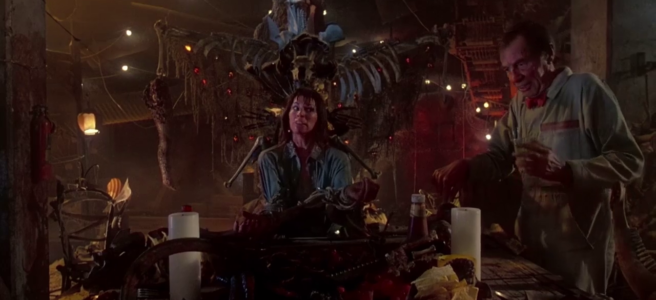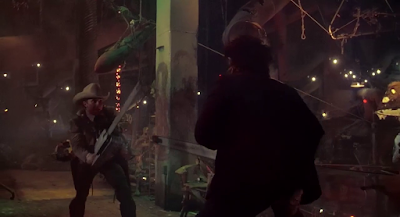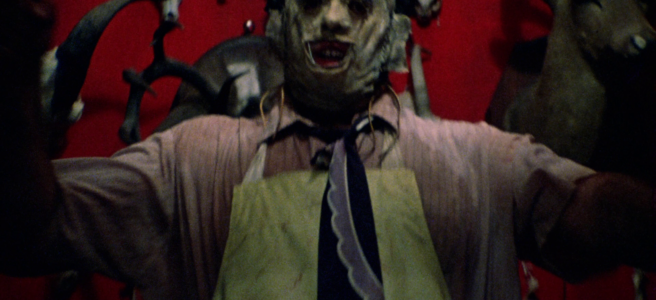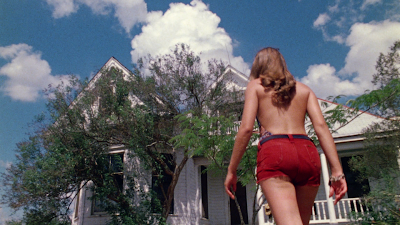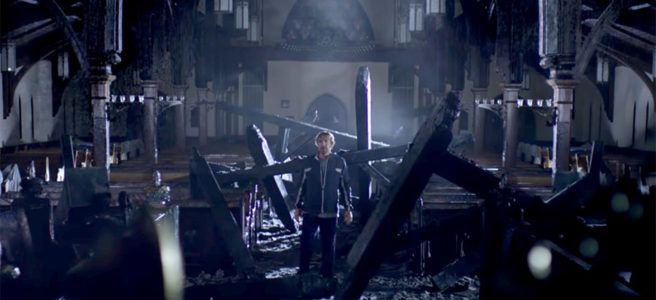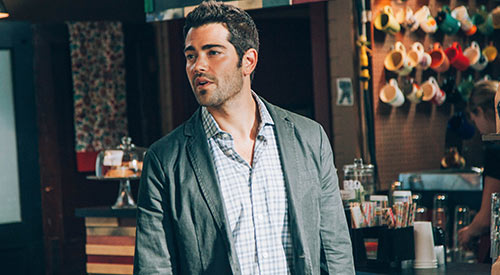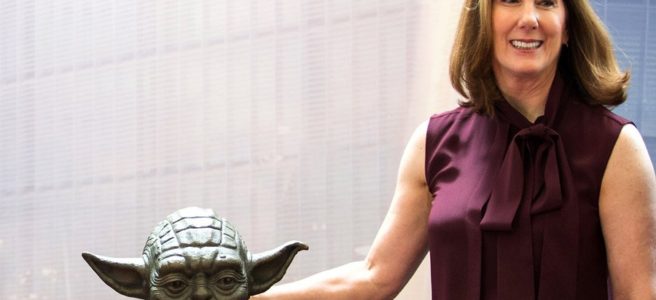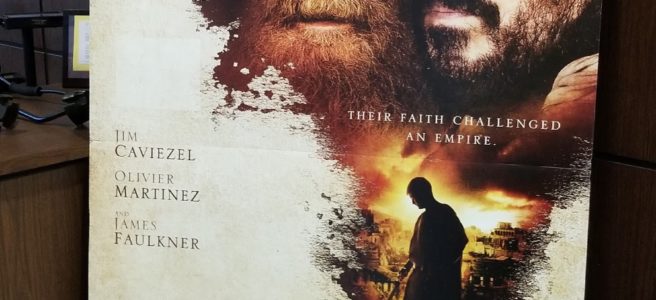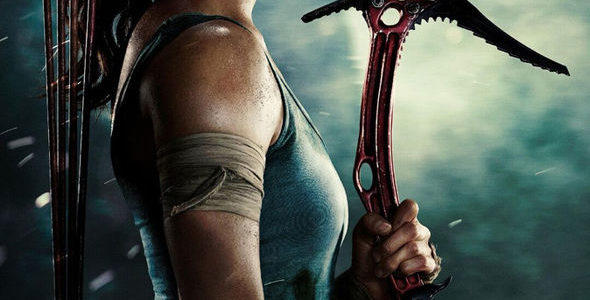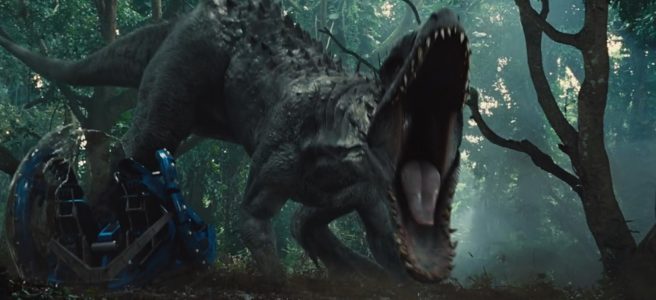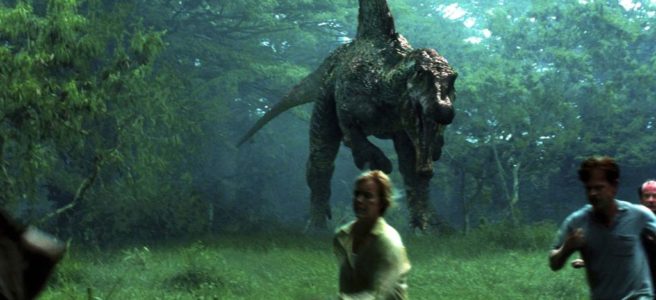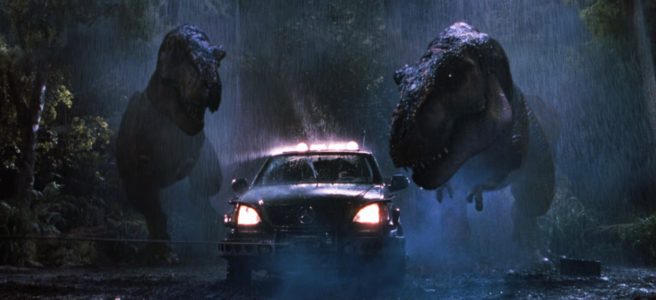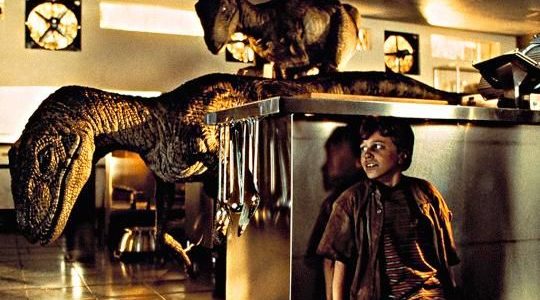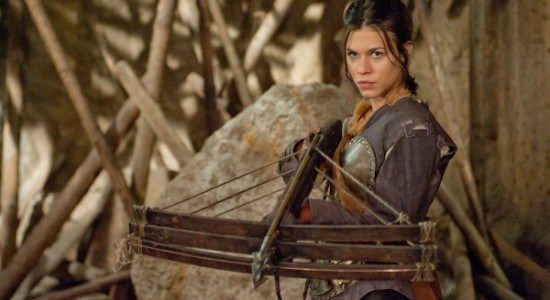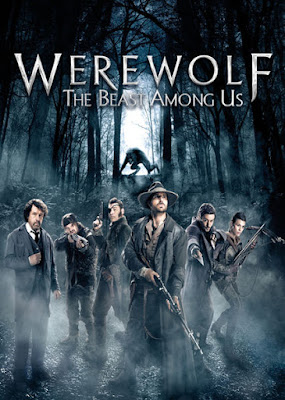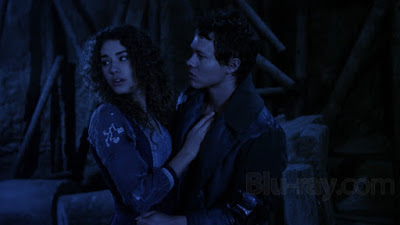Welcome back to The Texas Chainsaw Massacre retrospective! In this entry we’re going to be looking at the first sequel in the franchise, the aptly-titled The Texas Chainsaw Massacre 2! Like I mentioned in the previous entry, the my first introduction to this franchise was in a classic movie theatre showing the original film and its first sequel back-to-back. This film has amassed a very dedicated cult following, but does it hold a candle to the original film? Read on to find out…
PRODUCTION
Due to the very shady financing of the original Chainsaw, Tobe Hooper, the cast and the crew ended up seeing very little in return despite the film’s financial success. However, it went on to inspire other films and only four years after the release of The Texas Chain Saw Massacre, John Carpenter’s Halloween was released and kicked off the slasher craze of the 1980s. At this time, horror was becoming defined by gory exploitation films with high body counts, most readily exemplified by the Friday the 13th franchise, as well as the Halloween films, A Nightmare on Elm Street, Sleepaway Camp, Silent Night, Deadly Night, sequels to Psycho and countless one-off slashers hoping to become the next big thing. Perhaps inextricably linked to this increase in the popularity of slashers was the simultaneous rise in conservatism throughout the 80s, defined by the Reagan era. This was an age of moral panics and slasher films often became targets due to this (and as a result, many slasher films actually had their violence toned down significantly due to censorship, making them appear much tamer than films even 10 years later).
In the mid-80s and fresh off of the success of Poltergeist, Tobe Hooper signed a three-picture contract with Cannon films, a production company famous for creating a number of iconic, low-budget genre films during the 80s, such as Death Wish, Delta Force, Missing in Action, Masters of the Universe and, when they were on the verge of implosion, Superman IV: The Quest for Peace. As part of the three picture deal, Hooper had agreed to make a sequel to The Texas Chain Saw Massacre in exchange for high budgets and creative freedom on his projects for Cannon. However, his first two pictures, Lifeforce and Invaders from Mars, were financially unsuccessful and so the pressure was on for Hooper to deliver with Chainsaw 2. So desperate was Cannon for a hit that before the film had even been written they went ahead and set a release date and booked screens, leaving Hooper barely eight months to complete the film. Hooper approached celebrated screenwriter L.M. Kit Carson (fresh off of such films as Breathless and Paris, Texas). Despite the time crunch and the stigma associated with writing a slasher sequel which would “[wipe] your name right off the Serious Screenwriters’ Map”, Carson agreed to write the script as he had found Hooper’s original film enthralling and felt that the director was capable of tapping into madness unlike any other filmmaker.
According to Carson, “The first thing I told Tobe was, ‘You’re going to have to find the right victims […] One of the things the first movie had going for it was that people were really sick of hippies and enjoyed seeing a Volkswagen full of ’em squashed. So, I went home to Dallas and went to the Galleria, which is a yuppie feeding ground. I saw all these yuppies buying piles of things, seven sweaters at a time. I called Tobe up and said, ‘I’ve found the victims.'” Despite various sneering references in the screenplay to yuppies, the film only ended up featuring one scene with them being killed. However, there are deleted scenes which reveal that there were supposed to be several other scenes of Leatherface and Chop Top harvesting yuppies which were ultimately cut from the film, which leaves the whole idea of poking fun at yuppies largely absent from the film after the first ten minutes are over. According to Caroline Williams, this was due to differences between Cannon and Hooper – Hooper wanted to make a satirical black comedy, but Cannon wanted a more straightforward slasher film and took Hooper’s vision away from him before release.
The only returning cast member from the original Chainsaw was Jim Siedow as Drayton Sawyer. Gunnar Hansen was apparently approached to reprise his role as Leatherface, but turned it down (likely due to pay concerns) and the role went to Bill Johnson instead in his first (and arguably only) major role. The film’s publicist didn’t think that there was any sense in securing the original actors anyway, since none of them had achieved major stardom. Of the new cast, the female lead went to Caroline Williams as radio host Vanita “Stretch” Brock in her first leading role. The film also features Dennis freaking Hopper as Lefty Enright. He was already a big star by the time Chainsaw 2 came out and would only become even more notable as Blue Velvet would be released that exact same year! Also worth noting is Bill Moseley as Chop Top in his first major film role. Moseley, who would later go on to become a horror icon, received the role for having created a parody film called The Texas Chainsaw Manicure which Tobe Hooper loved. The other notable cast member was Lou Perryman as L.G., who had been a film crew member for the original Chainsaw and who would tragically be killed by a real-life axe murderer in his home in 2009. Oh, and I would be remiss if I did not mention that the legendary Tom Savini (of Dawn and Day of the Dead and Friday the 13th fame) was brought on to do the special makeup effects in this film!
Much like the original, Chainsaw 2 released to significant controversy, earning an X rating from the MPAA for its violence and was instead released unrated. At the time of release, it was banned in Germany, Singapore, the UK and Australia and would remain so for 20-30 years in these countries! However, its controversial impact was certainly not as widespread as the original’s was.
PLOT SYNOPSIS
Like its predecessor, Chainsaw 2 starts with an opening voice-over which tells the audience that Sally escaped and told authorities about the Sawyer family, but no evidence of the crimes could be found and authorities denied that there ever was a Texas chainsaw massacre (thereby contradicting the whole conceit of the previous film being based on true crimes). The film then follows a pair of dumb teenagers who have come to town to party and cause ruckus as they drive erratically, fire a freaking magnum at street signs and phone into the local all-request station to harass the radio host, Stretch. During their joyride they run a truck off of the road. Later in the evening, the pair call Stretch to harass her again when the truck they encountered earlier pursues them and a chainsaw-wielding maniac hacks them and their car to pieces. Stretch and her co-worker L.G. hear everything on the phone and Stretch decides to keep the tape because she believes that some sort of crime had just occurred.
The next morning, the scene of the car crash is investigated by Lieutenant “Lefty” Enright before the police can arrive. Lefty is Sally and Franklin’s uncle and has been investigating chainsaw-killer deaths around the state, trying to find the perpetrators. He convinces the police to put out a bulletin in the newspaper for any evidence of what happened to cause this accident. Stretch sees this bulletin and takes her recording of the incident to Lefty, offering to play it on the radio to flush the perpetrators out. Lefty is inexplicably skeptical and sends her away, but after purchasing some chainsaws he tracks her down and agrees to help.
That night, Stretch plays the recording of the incident, which upsets several locals. At closing time, Stretch encounters an eccentric, sinister-looking man who asks for a tour of the radio station and says that he liked the tape she played that night. Leatherface suddenly bursts out and attacks, causing Stretch to run and lock herself safely away while the other man, Leatherface’s brother Chop Top, looks for the recording of the killings. L.G. returns to the radio station and is brutally bludgeoned by Chop Top as Leatherface breaks into Stretch’s hiding place. However, instead of killing her, Leatherface finds himself aroused by her and decides to spare her. He lies to Chop Top about killing Stretch and then the pair escape with L.G.’s body. Stretch pursues the pair to an abandoned amusement park until Lefty arrives on the scene. However, Stretch falls down a shaft and ends up in the Sawyers’ meat locker. Meanwhile, Lefty enters the amusement park and starts becoming extremely erratic as he chainsaws the support beams down, hoping to collapse the entire building on top of the Sawyers.
Leatherface finds Stretch while he is skinning L.G.’s body. Not wanting her to be discovered and killed by the rest of his family, he tries to hide her under a mask made from L.G.’s face and then ties her up. However, L.G. is somehow still alive and he cuts Stretch free before finally succumbing to his wounds. She sneaks out and tries to get past the Sawyer family, but is spotted and chased. When they finally catch up to her, Drayton tells Leatherface to kill her, but he refuses and Drayton tells him that he’s going to have to decide between sex and family. When Leatherface still refuses, he gets angry and Chop Top knocks her out.
Stretch awakens in another dinner scene and is brought before Grandpa, who once again tries to bash her head in. However, before he can finish her off, Lefty arrives and chainsaws Drayton in the ass and then gets into a FREAKING CHAINSAW DUEL with Leatherface! Stretch flees and is pursued by Chop Top. Meanwhile, Lefty impales Leatherface with a chainsaw, but the pair continue to fight before a dying Drayton blows everyone up with a grenade. Only Stretch and Chop Top escape, fleeing to the top of the amusement part where Stretch finds grandma’s body with a chainsaw. She steals the chainsaw and then slashes Chop Top open with it, sending him tumbling to the ground before she screams and dances in victory.
REVIEW
If you can’t tell from that plot summary, The Texas Chainsaw Massacre 2 is a wildly different film than its predecessor. Whereas the original Chainsaw is gruelling and realistic, Chainsaw 2 is campy and over-the-top, aiming to be more of a horror comedy. You can probably imagine the whiplash I experienced going into these two films for the first time, back-to-back and completely unaware of what they were like! Perhaps Tobe Hooper was aiming for some of that true madness that L.M. Kit Carson was alluding to, but this film has some moments of utter batshit lunacy, frighteningly akin to the sort of stuff you might come across in Howling II (which was released only one year earlier… the 80s were a weird time for cinema). Some of this comes from the film striking a campy tone. This gets expressed in various ways throughout the film, but one method is through the portrayal of the amusement park setting, which makes me think of the goofiness of Mr. Freeze’s lair in Batman & Robin. The characters also feel more like “characters” than real people this time around as well. Even returning faces such as Drayton Sawyer have taken a mustache-twirling direction with his oversized van and gleeful cheering about his famous chilli recipe.
Scenery-chewing absolutely abounds in this film and while Jim Siedow tries his best, the most amazingly campy performances in this film go to Bill Moseley and Dennis Hopper without question. Bill Moseley’s Chop Top is a revelation, especially considering that this was his first major role. From his first moment on screen he is enthralling to watch, gleefully eccentric and dangerously unhinged. Even his character ticks of scratching his exposed metal plate with a hot wire and eating bits of his necrotic skin is fascinating, and he actually manages to get across the character’s Vietnam veteran background without having to hammer the audience with exposition. Chop Top is by far the best aspect of this film and effectively demonstrates that having a family of serial killers is a fantastic asset for the Chainsaw franchise to capitalize on.
Meanwhile, Dennis Hopper’s Lefty Enright is just baffling to witness. On his introduction, he comes across like the hero of the film, a Dirty Harry-style hero who’s going to come into town and stop the chainsaw killers. However, it soon becomes apparent that he’s about as deranged as the people he’s hunting and he even uses Stretch and L.G. as bait to lure the Sawyers out of hiding. We don’t really get a sense of just how much of a nut he is though until he gets to the amusement park and then starts screaming like a crazy person, quoting made-up scripture (“I am the Lord of the Harvest…”) and repeatedly yelling “BRING IT ALL DOWN!!! MAY THE LORD HAVE MERCY ON OUR SOULS!!!” like a madman. It’s hilarious and I’m sure that Dennis Hopper is the one who is making it all so gloriously over-the-top, because it makes absolutely no sense in the context of the film for this character to be so bonkers. He even gets into a dual-wielding chainsaw duel with Leatherface and wins, which might be the most badass concept ever put to film (until 10 years later when Kurt Russel would surf a tidal wave through downtown Los Angeles onto the back of Steve Buscemi’s car to punch him in the face). That’s right, this is a character who believes that the only way to beat chainsaw-wielding maniacs is by being even more of a maniac with even more chainsaws.
With all the scenery chewing going on, it’s easy to lose Caroline Williams’ lead performance was Stretch in the shuffle, but I have to give her credit for being a great in this film. She gets put through the freaking wringer throughout Chainsaw 2, getting harassed by the yuppies, getting used as bait by Lefty, getting chased around by murderous maniacs and having to deal with deeply uncomfortable rape vibes from Leatherface throughout the whole ordeal. Unlike Sally in the previous film, she actually gets a chance to fight back on occasion and uses her own cunning to pacify Leatherface enough to stay alive (despite the aforementioned rapey vibes). In my opinion, she’s definitely the best final girl in the whole franchise.
As for Leatherface, his performance is… different. He doesn’t come across quite as dangerously stupid as he was in the first film and his mental deficiencies feel more like a gimmick than central to the character. I also don’t really like how the whole “sexual awakening” subplot was handled because it turns the character into something of a joke and is just deeply uncomfortable to witness. When Leatherface breaks into Stretch’s hiding place, he gets aroused while waving his chainsaw around and soaking Stretch in beer. Stretch seems to understand what’s going on and keeps egging him on, saying “You’re really good, aren’t you?” He then sticks his chainsaw between her legs and makes what can only be described as an o-face before he revs his chainsaw orgasmically and destroys the room in ecstasy… I mean, holy shit, it’s the sort of scene that I can barely believe exists, but there it is. It also makes Leatherface’s chainsaw gimmick retroactively icky, since it explicitly makes the chainsaw a penis metaphor, an association which I would argue isn’t particularly appropriate for this character since he has never really been about masculine aggression or sexualized violence (in fact, gender ambiguity was very much an element of the character that the previous film established). Having to spend the bulk of his scenes getting outshone by Chop Top is bad enough, but I just don’t find Leatherface nearly as compelling in this film. The only character moment he got that I really liked was when he finds Stretch in the meat locker and tries to hide her under a mask made from L.G.’s face skin, showing a bit more of the character’s twisted but identifiable logic, as he believes that this mask will keep her safe like it does for himself. Oh and speaking of skin masks, I am not a huge fan of his mask in this film, it looks much more rubbery than the previous film and more like a scary mask prop.
I’d also be remiss if I neglected to mention Tom Savini’s contributions to this film. While I feel like it’s some of his lesser work (in part perhaps because his best makeup effects were apparently left on the cutting room floor), there are some pretty gnarly scenes in this film, such as a yuppie getting his head chainsawed in half and Leatherface getting impaled by a chainsaw during his duel with Lefty. By far the most impressive effect in the film though is L.G.’s partially-skinned and face-less corpse standing up and helping Stretch while she’s wearing his face. It’s incredibly gruesome seeing the exposed muscle and bones and the makeup effects make far and away the most horrifying moment in the film.
How about this film’s themes? The original film had some surprisingly interesting themes beneath its simple exterior; could its sequel channel a similar spirit to comment on society in the 80s? Well… that is hard to say definitively. Defenders of the film, such as Joey Click at Fansided, like to point out that it “is a response to ’80s consumerism and the rise of yuppie culture. A perfect companion to John Carpenter’s They Live, The Texas Chainsaw Massacre 2 is a film steep in ideas of the almighty dollar becoming king […] From the opening, where the Sawyers literally kill two spoiled yuppies, the film is full of examples of pushing back against a culture emerging from Reaganomics. The Sawyers are feeding victims to people, so it’s almost literal.” Tobe Hooper and L.M. Kit Carson’s discussions about what the film reveal that it was conceived to support these ideas. However, I feel like there was something lost in translation. I didn’t grow up in the 80s so maybe I’m missing some of the context, but the film we got doesn’t feel like the biting satire that its defenders claim it is. As it is, we’ve got two yuppies getting gleefully murdered and then an hour and twenty minutes of a radio host getting terrorized by maniacs. Drayton makes a couple barbs once again about how small businessmen are getting screwed by Reagan’s politics, but again, when the film is about a regular, small town radio host getting terrorized it’s hard to say that this serves much thematic point. I don’t think you can justifiably call a film a satire of 80s consumer culture when only the opening scene makes any real substantial reference to it. If the deleted scenes of Leatherface and Chop Top killing yuppies had made their way into the film then it might have achieved that vision, but the film that was released does not. For what it’s worth though, Joey Click also claims that the original Chainsaw had no themes or commentary though, so take their opinion as you will.
The Texas Chainsaw Massacre 2 is a bit of a mess of a film. It’s all over the place and it definitely feels like the seven month production schedule seriously compromised the final product, not to mention the indications that Cannon screwed with Hooper’s vision for the sequel. However, I can appreciate its attempts to do something different and it is certainly never boring. There are also some fantastic individual elements, especially Bill Moseley’s standout, iconic performance. Hell, there are also some very memorable lines in this film, from the iconic “the saw is family”, to Dennis Hopper screaming “I am the Lord of the Harvest…”, “May God have mercy on us all!!!” and “BRING IT ALL DOWN!!!” It’s not the sort of sequel that I would have liked to see from the original creators, but I have warmed to it slightly more after understanding what it is that they were going for. It really is a bonkers film though, so I can only give it so much credit.
4.5/10
Be sure to tune in soon as we take a look at the third entry in the franchise, Leatherface: The Texas Chainsaw Massacre III!
